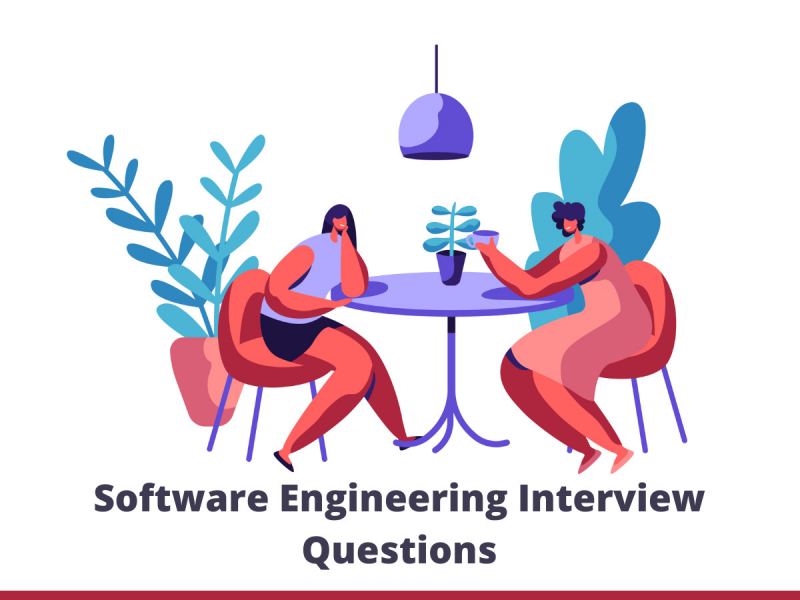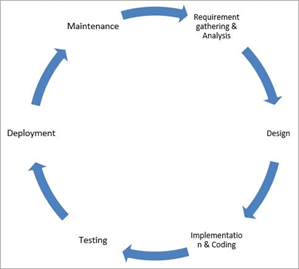Software Engineering Interview Questions
 Download Software Engineering Interview Questions PDF
Download Software Engineering Interview Questions PDFBelow are the list of Best Software Engineering Interview Questions and Answers
Software engineering is a branch of computer science that deals with the building and growth of the software for both computers and applications. Computer system software uses the operating system and computing utilities whereas application software includes user-focused programs like database, programs, web browser, etc.
There are mainly 6 phases of SDLC:
- Requirement gathering and analysis
- Design
- Implementation or coding
- Testing
- Deployment
- Maintenance

Answer this question according to yourself as to what programming languages you have used or have knowledge for example C, C++, Java, Python, etc. Also, elaborate about the project if you have done any of these.
The important categories are:
1.System Software: System software term is used to describe those computer programs that are essential to start computer systems and run application software and networks. The system software is used for the interaction between the user and the hardware. These types of software manage computer hardware behavior so that it can provide basic functions that are important for users. In other words, it is a bridge between the user and the hardware system of the computer.
2.Application Software: Application software is also known as end-user programs, used to perform the task like online research, setting an alarm, jotting down notes, designing graphics, calculations, keeping an account log, playing games. In comparison to system software, application software is used by the end-user. Application software is specific for a task. For example, a browser is an application for online search, MS PowerPoint is used to work on the presentation.
3.Open-source: As the name suggests, this software is available to the user with their code source. The advantage of these types of software is that the user can change or modify the software as per the wish. Open-source software can either be free or chargeable. An example of open –source software is Mozilla Firefox Thunderbird.
Software re-engineering as the name suggests is a process of examination and updating software without affecting its functionality. It may update the quality, service, speed of delivery, and software cost in a positive way. Modification can be performed by adding new features and by developing additional functionalities. This process is a step forward to improve the efficiency of the software for it to be handled better by the user.
SDLC Model which are widely accepted and used are mentioned below:
- Waterfall model
- Iterative model
- Spiral model
- V-shaped model
- Agile model
AJAX stands for Asynchronous JavaScript And XML used to create the asynchronous web applications. AJAX is not a programming language, instead, it uses a set of web development technologies like HTML and CSS.AJAX is used in web applications to send and retrieve the data from the server without disturbing the behavior and display of the existing page. As the data exchange occurs behind the scene, the web page can update without reloading the whole page.
Advantage of AJAX: -
- Speed: One of the main advantages is that it reduces the time and server traffic on both sides.
- Interaction: AJAX is responsive and able to transmit the whole page at a time.
- XMLHttpRequest: Ajax uses the XMLHttpRequest to transfer the data to both sides. It is used for making requests to non-Ajax pages.
- Asynchronous calls: As AJAX makes asynchronous calls to the server, it means the browser doesn't have to wait for all the data to arrive before start rendering.
- Form Validation: Another advantage is that AJAX provides proper Validation.
- Bandwidth Usage: It is riveting that with the help of AJAX fetching of data from the database or storing data into the database can be performed without reloading the page. This enhances both performance and speed.
Blackbox testing, known as Behavioral testing is a software testing method which is used to test the software by focusing on the input and output. It does not require any knowledge of internal code, internal path, and implementation details of the software application.
You can test any software application which you want to. From the operating system to the database, the black box can be used to detect the system. The only thing you need for this is the input and the output. It doesn’t demand any internal code.

A feasibility study in software engineering is done by engineers to analyze the feasibility of the project. It is performed to check whether the condition of implementing the project is accepted or not in terms of implantation and development. It is one of the four stages of the software project management process. It detects whether the software product is beneficial for the organization or not.
The methods are:
- Brainstorming: This method means the collection of ideas and solutions to the problem of common people.
- Document Analysis: This method consists of reviewing the existing document of the system. It gives ample knowledge of the system.
- Focus Group: This method is used to collect feedback from the users or people.
- Interface analysis: Interface can be a human or a machine. The interface is the integration of the system with the external system. In this, the system is analyzed with the external system so that the project can perform better.
- Interview: In this process, an interview of stakeholder and user is taken place so that the perspective of them can be understood.
- Observation: An analyst from the interview observes the key points that can help in developing a group. They analyze steps, pain points, the process flow, and opportunities to improve the project.
- Prototyping: It is used to collect the requirements to build the initial version of the design
- Survey: It consumes a lot of time for the interview so a survey is held where the required questions are asked to the customer and their answers are analyzed.
In software engineering, Modularization is a technique that divides the software system into various separate and independent modules. These different modules then work irrespective of each other.
These modules are the fundamental unit for the entire software. The modules are built in such a manner that they can perform or execute independently. Modular design, therefore, uses the divide and rule strategy to work efficiently.
DFD stands for a data flow diagram that represents the information in a system. It tells about the system requirement. DFD can be automated, manual, or both.
DFD also tells about the flow of data, the cause of the change of information, and the location of the data where it is stored. DFD is referred to as a data flow graph and bubble chart and it shows the boundaries and scope of the system.
There are 3 levels of a Data flow diagram which are given below: -
0 – level DFD
1 – level DFD
2 – level DFD
ER diagram (Entity Relationship diagram) is a flowchart that is used in database design. As the name suggests, it describes the relationship between entities. An entity can be anything like people, objects (tangible and intangible), or concept. In software engineering, ERD is used to design or debug relational databases. ERD utilizes various symbols like ovals, diamonds, rectangles,s and connecting lines to represent the relation, interconnectedness, and attributes of entities.
Some of them are mentioned below:
- Corrective Software Maintenance
- Adaptive Software Maintenance
- Perfective Software Maintenance
- Preventive Software Maintenance
Coupling: The coupling term is used to describe the degree of interdependence between the modules. Lower the coupling between the modules, the better the software is.
Cohesion: The cohesion term is used to describe the degree to which the elements of the module are related. Cohesion is a glue that connects all the modules together. All the elements of the module work together to perform a single task.
Higher the cohesion of the system, the better the software is.
Software requirement specification also recognizes as SRS is a document or set of documents that explain the software system. It also includes the details of the requirements (functional or non-functional) of the user that the software must provide.
RAD stands for Rapid Application Development model. The limitations of RAD are: -
- It is not possible to use this method for large, highly, or unique complex projects.
- A strong team is required for identifying the business. A lack of motivation in a team can’t work by using this method.
- Developers with good knowledge and skills can use this method only.
- Only systems that can be modularized are able to use RAD.
- This method cannot be used for cheaper projects because the cost of automated code and modeling is quite high.
In software engineering, software prototyping is the prototypes of software applications which are referred to as incomplete versions of the software program that is yet to be developed. Its benefits are:
- A Fail early and inexpensively: The risk of failure always exists in real innovation. With the help of the prototype, it is easy to remove the approaches that don't work. In this way, the developer can focus on approaches that will work.
- Reduced time and costs: With the help of the prototype, both the quality and requirement of the specification can be improved. Customers can expect the higher cost and the hurdles associated with the project and they can also anticipate the potential result of the disaster.
- Technically understand the problem: It is always better to understand the problem that has to be faced before developing the software. By creating a prototype, it is easy to analyze the technical challenges to create the design. After that, it is quite easy to implement the solution to a more elegant system.
- Conflict resolution: Engineers have different ideas on how a certain feature can be implemented. With different opinions, it is not easy to decide the final product. But thanks to prototyping, we can create different iterations of the feature and analyze the resulting performance. Thus, prototyping not only saves time but also helps in deciding the best design.
- Funding: If the prototype is working, then there is a probability that your final design will also work. The major advantage is that it reduces the risk for the investor to invest in your project.
- Easily file patents: Prototype can also be used to patent your idea. So, it is the best and safest way to use a prototype.
A baseline is a reference point in the software development for change in management. The main aim of the baseline is to minimize the project’s vulnerability by maintaining key deliverables at some point in life cycle
Also Read Related Software Engineering Interview Questions | ||
|---|---|---|
| PHP Interview Questions | HTML Interview Questions | |
| Core Java Interview Questions | Hibernate Interview Questions | |
| Design Pattern Interview Questions | HCL Testing Interview Questions | |
Latest Interview Questions-
Silverlight Interview Questions
-
Entity framework interview questions
-
LINQ Interview Questions
-
MVC Interview Questions
-
ADO.Net Interview Questions
-
VB.Net Interview Questions
-
Microservices Interview Questions
-
Power Bi Interview Questions
-
Core Java Interview Questions
-
Kotlin Interview Questions
-
JavaScript Interview Questions
-
Java collections Interview Questions
-
Automation Testing Interview Questions
-
Vue.js Interview Questions
-
Web Designing Interview Questions
-
PPC Interview Questions
-
Python Interview Questions
-
Objective C Interview Questions
-
Swift Interview Questions
-
Android Interview Questions
-
IOS Interview Questions
-
UI5 interview questions
-
Raspberry Pi Interview Questions
-
IoT Interview Questions
-
HTML Interview Questions
-
Tailwind CSS Interview Questions
-
Flutter Interview Questions
-
IONIC Framework Interview Questions
-
Solidity Interview Questions
-
React Js Interview Questions
Subscribe Our NewsLetter
Never Miss an Articles from us.
